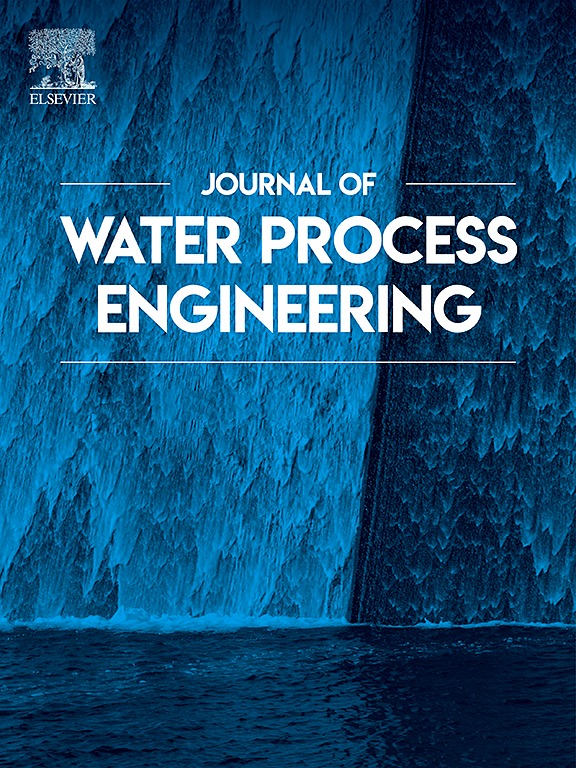Spatial and temporal dynamics of methane and carbon dioxide fluxes in a constructed wetland
IF 6.3
2区 工程技术
Q1 ENGINEERING, CHEMICAL
引用次数: 0
Abstract
Constructed wetlands (CWs) are increasingly adopted as a nature-based solution for wastewater treatment. However, given their affinity with natural wetlands and high degradation of organic pollutants, their classification as a sustainable ‘green’ technology is questioned due to potentially high greenhouse gas (GHG) emissions. While methane (CH4) and carbon dioxide (CO2) emissions from natural wetlands and ponds have been widely studied, fluxes from CWs remain underexplored. To address this knowledge gap, CH4 and CO2 fluxes were measured from the Ingoldisthorpe integrated CW and an adjacent natural pond, located in the UK using the floating chamber method with gas chromatography, alongside climate and water quality monitoring. Mean seasonal CH4 fluxes ranged from 0.13 ± 0.18 mg CH4 m−2 h−1 (autumn) to 20.52 ± 45.01 mg CH4 m−2 h−1 (spring), with ebullition contributing 25–93 % of total spring-summer CH4 flux. When CH4 was converted to CO2 equivalents, the CH4:CO2 seasonal ratio revealed a greater contribution of CH4 to the CW emission potential in spring-summer and CO2 (mg CO2 m−2 h−1) in autumn-winter, resulting in a mean annual global warming potential (GWP) of 3.76 kg CO2-eq m−2 year−1. Temporal temperature variability significantly influenced CH4 ebullitive fluxes, while spatial variability of water depth and velocity were key drivers of CH4 and CO2 diffusive fluxes. The absence of ebullitive flux in the natural pond adjacent to the CWs was attributed to its lower eutrophic conditions than the CWs. However, no significant differences in overall GHG emissions were observed between the CWs and the natural pond. Overall, our findings capture the complex temporal and spatial variability of GHG fluxes in CWs, highlighting the importance of comprehensive sampling to inform more accurate GHG budgeting and support evidence-based design and management strategies for sustainable CW systems.

人工湿地中甲烷和二氧化碳通量的时空动态
人工湿地(CWs)越来越多地被采用为基于自然的废水处理解决方案。然而,考虑到它们与天然湿地的亲和力和有机污染物的高度降解,由于潜在的高温室气体(GHG)排放,它们被归类为可持续的“绿色”技术受到质疑。虽然对天然湿地和池塘的甲烷(CH4)和二氧化碳(CO2)排放进行了广泛的研究,但对化粪池的通量仍未充分探索。为了解决这一知识差距,研究人员使用气相色谱浮动室法测量了Ingoldisthorpe综合CW和邻近天然池塘的CH4和CO2通量,同时对气候和水质进行了监测。平均CH4季节通量为0.13±0.18 mg CH4 m−2 h−1(秋季)~ 20.52±45.01 mg CH4 m−2 h−1(春季),其中冒泡占春夏CH4总通量的25 - 93%。当CH4转换为CO2当量时,CH4:CO2的季节比值显示CH4对春夏和秋冬的连续波排放势(mg CO2 m−2 h−1)的贡献更大,导致年平均全球变暖势(GWP)为3.76 kg CO2-eq m−2 year−1。温度的时间变异显著影响CH4沸腾通量,而水深和流速的空间变异是CH4和CO2扩散通量的关键驱动因素。靠近化学武器的天然池塘没有沸腾通量,其富营养化条件比化学武器低。然而,人工水塘与天然水塘的温室气体总排放量并无显著差异。总体而言,我们的研究结果捕捉到了温室气体通量的复杂时空变异性,强调了全面采样的重要性,为更准确的温室气体预算提供了信息,并为可持续的温室气体系统的循证设计和管理策略提供了支持。
本文章由计算机程序翻译,如有差异,请以英文原文为准。
求助全文
约1分钟内获得全文
求助全文
来源期刊

Journal of water process engineering
Biochemistry, Genetics and Molecular Biology-Biotechnology
CiteScore
10.70
自引率
8.60%
发文量
846
审稿时长
24 days
期刊介绍:
The Journal of Water Process Engineering aims to publish refereed, high-quality research papers with significant novelty and impact in all areas of the engineering of water and wastewater processing . Papers on advanced and novel treatment processes and technologies are particularly welcome. The Journal considers papers in areas such as nanotechnology and biotechnology applications in water, novel oxidation and separation processes, membrane processes (except those for desalination) , catalytic processes for the removal of water contaminants, sustainable processes, water reuse and recycling, water use and wastewater minimization, integrated/hybrid technology, process modeling of water treatment and novel treatment processes. Submissions on the subject of adsorbents, including standard measurements of adsorption kinetics and equilibrium will only be considered if there is a genuine case for novelty and contribution, for example highly novel, sustainable adsorbents and their use: papers on activated carbon-type materials derived from natural matter, or surfactant-modified clays and related minerals, would not fulfil this criterion. The Journal particularly welcomes contributions involving environmentally, economically and socially sustainable technology for water treatment, including those which are energy-efficient, with minimal or no chemical consumption, and capable of water recycling and reuse that minimizes the direct disposal of wastewater to the aquatic environment. Papers that describe novel ideas for solving issues related to water quality and availability are also welcome, as are those that show the transfer of techniques from other disciplines. The Journal will consider papers dealing with processes for various water matrices including drinking water (except desalination), domestic, urban and industrial wastewaters, in addition to their residues. It is expected that the journal will be of particular relevance to chemical and process engineers working in the field. The Journal welcomes Full Text papers, Short Communications, State-of-the-Art Reviews and Letters to Editors and Case Studies
 求助内容:
求助内容: 应助结果提醒方式:
应助结果提醒方式:


